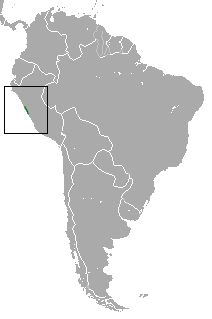| Tate's fat-tailed mouse opossum | |
|---|---|
| Scientific classification | |
| Kingdom: | Animalia |
| Phylum: | Chordata |
| Class: | Mammalia |
| Infraclass: | Marsupialia |
| Order: | Didelphimorphia |
| Family: | Didelphidae |
| Genus: | Thylamys |
| Species: | T. tatei |
| Binomial name | |
| Thylamys tatei Handley, 1957 | |
 | |
| Tate's fat-tailed mouse opossum range | |
Tate's fat-tailed mouse opossum (Thylamys tatei) is a species of opossum in the family Didelphidae, [2] named after American zoologist George Henry Hamilton Tate. [3] It is found at elevations of 300 to 3,000 m along the coast of central Peru. [1] The species has the northernmost range of any member of its genus. [1] It has white ventral fur and short condylobasal and zygomatic lengths. T. pallidior is very similar. [4]
